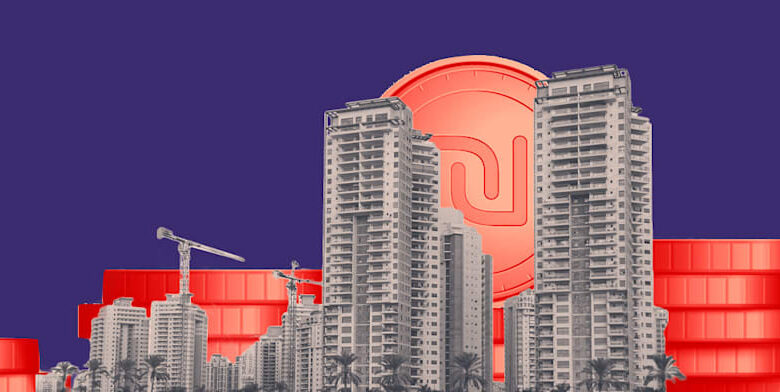Israel’s housing price rise riddle

Are price of new apartments in Israel about to fall? An analysis by “Globes” has found that the supply of new apartments in several cities, especially in the Tel Aviv area, is sufficient for more than 3 years, and poses a serious challenge to real estate developers. However, prices, as of now, are not falling.
According to the analysis conducted by “Globes” from data published by the Central Bureau of Statistics and the Israel Tax Authority on the supply of apartments in Israel and the sale of new apartments, Kiryat Ono is the most difficult city for real estate developers to sell apartments. The city is swamped with a supply of 1,550 new unsold apartments, but at the current sales rate, it will take developers eight years to sell the inventory. Ramat Gan, Ra’anana, Bat Yam, Beit Shemesh and Tel Aviv are also flooded with apartment inventory, which will take developers years to offload.
It will take over two years to sell the national inventory
While the supply of new apartments is increasing, there is a decline in the number of completed deals in the market. In the first two months of 2025, about 2,200 apartments were sold per month on the free market, compared to a monthly average of about 3,100 apartments sold on the free market in 2024, which is also quite low. Weak sales mean developers are stuck with their apartment inventory for longer. According to the Central Bureau of Statistics, on a national average, the current inventory of 78,000 new apartments, will take more than two years to offload at the current sales rate.
Yet prices continue to rise, and it is likely that at least part of the explanation lies in the 20% (pay now) 80% (pay on occupancy) offers, with contractor’s loans, which provide buyers with profitability in a different way than price reductions. However, the question is how long can this situation will last, especially since the Bank of Israel’s patience with financial sales promotions has expired and it has instructed banks to restrict them?
Big supply of apartments in the center of the country
Examining the geographical distribution of unsold new apartments finds that 45% are in the Tel Aviv and central districts; 13% in each of the Jerusalem and southern districts; about 15% in Haifa and the north; and the rest in Judea and Samaria.
Due to this, it is no wonder that the large supply of apartments in the cities of the Tel Aviv metropolitan region does not match the decreasing pace of purchases. The inventory of apartments in the south and north more or less matches the pace of purchases.
Central Bureau of Statistics data also indicate the supply of apartments in large and small cities where the supply is exceptional. Cities that stand out in terms of supply are Tel Aviv, with 9,263 new unsold apartments, Jerusalem 7,489, Bat Yam 4,130, Ramat Gan 3,565 and Netanya, which has 3,489 new unsold apartments.
RELATED ARTICLES
The situation in these cities is extremely challenging, and the supply is large, but considering the pace of sales (in Tel Aviv and Jerusalem, for example, it stands at about 260 new apartments per month, compared to a few dozen in smaller cities), the situation there is not necessarily the most problematic.
It will take years to get rid of the apartments
To examine the full picture, “Globes” gathered data from the Israel Tax Authority and the Central Bureau of Statistics about deals for new apartments that took place in the six months between September 2024 and February 2025. “Globes” calculated the average monthly sales rate (i.e. how many new apartments are sold in these locations per month) and divided the stock of unsold apartments by the sales rate, obtaining the time remaining until the supply is exhausted in each of the locations.
Thus, in Kiryat Ono, 1,550 new unsold apartments were counted in February 2025 by the Central Bureau of Statistics, but the monthly rate of apartment purchases in this city in recent months is just 16 putting it in first place in the ranking of how long it will take to sell off all the new apartments.
At the current sales rate, and if the surrounding conditions (prices, interest rates, macroeconomic situation, etc.) do not change, it will take developers eight years to run down the supply of apartments in the city.
In second place is Ramat Gan with a supply of 3,565 new apartments that will take over four years to sell. In demand Ra’anana came in third place with a stock of 1,410 new apartments and an average sales rate of 35 apartments per month. It will take developers almost three and a half years to run down the inventory. Also high in the rankings are Bat Yam, Beit Shemesh, Tel Aviv, Ashdod and Netanya, which at the current sales rate will take developers over two and a half years to sell all their apartments.
In the south, on the other hand, “Globes” found inventory that more or less matches demand. In Beersheva, Netivot, and Ofakim, the supply of apartments will be exhausted within a year or less. However, a significant portion of the construction in these cities is allocated to government subsidized housing programs, and therefore the data is less significant. The same is true for Beer Yaakov and Kiryat Bialik.
Published by Globes, Israel business news – en.globes.co.il – on April 16, 2025.
© Copyright of Globes Publisher Itonut (1983) Ltd., 2025.
https://res.cloudinary.com/globes/image/upload/t_800X392/v1614773392/COT_Pic/150_rcr7eu.jpg
2025-04-16 01:15:00





